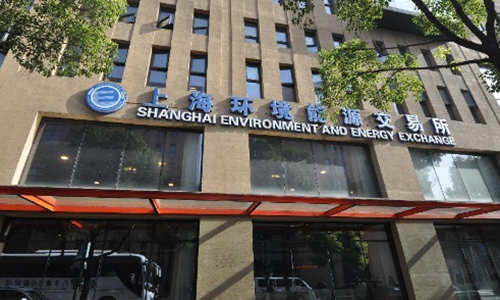
Photo taken on Nov. 26, 2013 shows the exterior of the Shanghai Environment and Energy Exchange(SEEE) where the inaugural ceremony of the carbon emission trading program is held in Shanghai, east China. Shanghai launched carbon emission trading on Tuesday, China's second market for compulsory carbon trading. (Xinhua/Shen Chunchen)
China is set to become the world's largest carbon emissions trading market in terms of the volume of greenhouse gases it handles, once the national-level exchange opens later this month, a Chinese official said on Wednesday.
Analysts and industry insiders are optimistic about the development of the carbon market and related industries, but there are gaps, mainly in finance, between China and mature carbon markets in Europe and the US.
"The electricity industry alone will make China the largest carbon market in the world. If other sectors are included later, China's carbon market may exceed all other carbon markets, which will attract a huge amount of capital and technological investment," Wang Jun, director of carbon asset management of Sichuan Yongxiang Co, told the Global Times on Wednesday.
China can even establish a global carbon trading and financing center with the help of its massive carbon market, Wang added.
The first participants in the national carbon trading market will include 2,200 power enterprises, with total carbon emissions of about 4 billion tons annually, Zhao Yingmin, vice minister of the Ministry of Ecology and Environment, said on Wednesday at a press conference.
Emissions from installations covered by the EU Emissions Trading System (ETS) decreased 9.1 percent in 2019 compared with 2018, equivalent to152 million tons of carbon dioxide (CO2), according to an annual report from the European Commission.
As a carbon trading market will soon open in China, carbon allowances have become more important to enterprises and carbon has become a new kind of currency. Carbon's financial function needs to be improved in China, with more financial derivatives related to emissions allowances expected on the market, analysts said.
"At present, only spot trading will be supported [on China's carbon market]. Derivatives such as futures, options and swaps have not yet been launched, although these have been available in the EU for many years," said Wang.
He added that there are big differences in views in China on whether to add such derivatives. "This also has something to do with the fact that China's financial regulators are not deeply involved in the carbon market."
Ye Yanfei, director of the Policy Research Bureau of the China Banking and Insurance Regulatory Commission, said on Wednesday that carbon emissions rights, which serve as collateral for the future, is "something that can be explored."
"Carbon emissions rights can provide the basis for banks to expand financing," Ye said.
Ye said that China's carbon emissions total about 10-11 billion tons a year, while green credits support 700 million tons of CO2 reductions annually.
China also has to make progress in carbon pricing, which is at present one-tenth of that of the ETS.
As of the end of 2020, the carbon price in China's pilot areas varied from 14-90 yuan ($2.16-13.9) per ton, while the price in Europe stood at about 50 euros ($58.9) per metric ton. Analysts predict that the price on the national carbon market is expected to start at 30-50 yuan.
"Carbon assets have been recognized by the majority of financial institutions and become one of the main targets of their asset allocation. However, at present, the national carbon market has not been opened to other institutions and individuals, except for emissions control enterprises," said Wang.
The liquidity of China's carbon market needs to be improved. Involving 2,000 enterprises, all from the power sector, is far from enough, an analyst of green finance and the low-carbon economy surnamed Xu told the Global Times on Wednesday.
No matter how carbon emission quotas are allocated, the optimal allocation can be achieved through marketization, according to the Coase Theorem, according to Xu.
"However, due to the low liquidity of China's carbon trading market, carbon emissions quotas cannot be effectively circulated. Therefore, the government should issue carbon emissions allowances at an early stage to boost circulation," said Xu.




